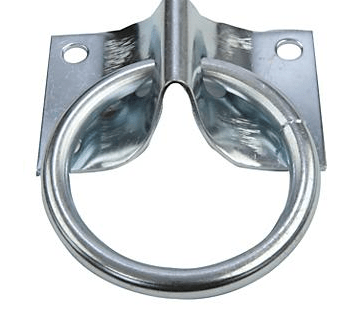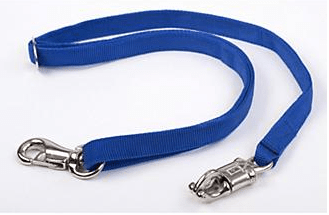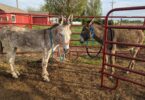Every equestrian needs to know how to tie a horse safely
Whether you’re tying a horse for grooming, trailering, tacking up, or the farrier, it’s important to know how to use a hitching rail safely. In this article, we’ll talk about how to tie safe and simple horse knots.
When tying a horse to a hitching post, you should always use a quick-release knot. As the name implies, these knots allow you to free your horse in a hurry should he pull back, get caught, or otherwise need to be moved elsewhere for safety ASAP.
Struggle to remember how to tie different knots or want to learn more? Pick up a set of my favorite horse tying pocket guide — Reference Ready: Essential Horse Knots.
Think Like a Horse
Before we talk about specific knots, it’s important to understand basic equine behavior.
Horses are prey animals, their first instinct is to run away from a threat.
A “spook” is a horse’s natural reaction to something scary; generally, the horse will jump sideways or quickly change direction with the intent to run away. Spooking can be dangerous whether you’re riding or not.
Since horses are hardwired to constantly be on the lookout for predators, it’s no wonder that being restrained or tied may feel unnatural to them.
When tying up a horse, try to think like one:
- Is anything in the surrounding area likely to spook your horse?
- How might your horse react if he becomes scared and wants to flee?
- Do any nearby objects pose a threat of being stepped on or entangling your horse?
- What will your horse be able to see and hear from the location?
- What will your horse not be able to see or hear from the location?
If you’re rounding a corner or opening a door, always announce yourself with “Coming around!” so any nearby horses won’t be surprised.
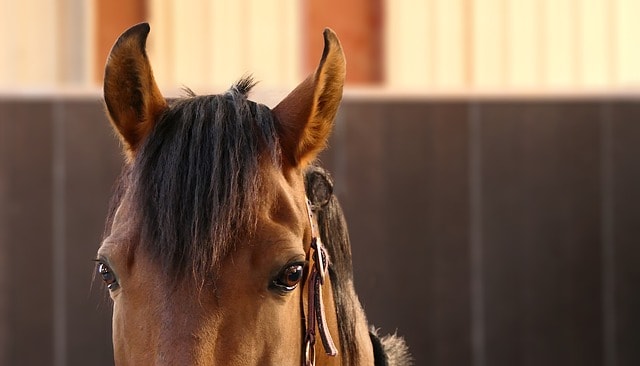
Put yourself in your horses’ shoes
Hitching Posts & Rings
Horses are commonly tied to a large, sturdy piece of wood (or sometimes metal) called a hitching post (i.e. hitching rail).
Some hitching posts feature metal hitching rings, which can be easier to tie a lead rope to than the post itself.
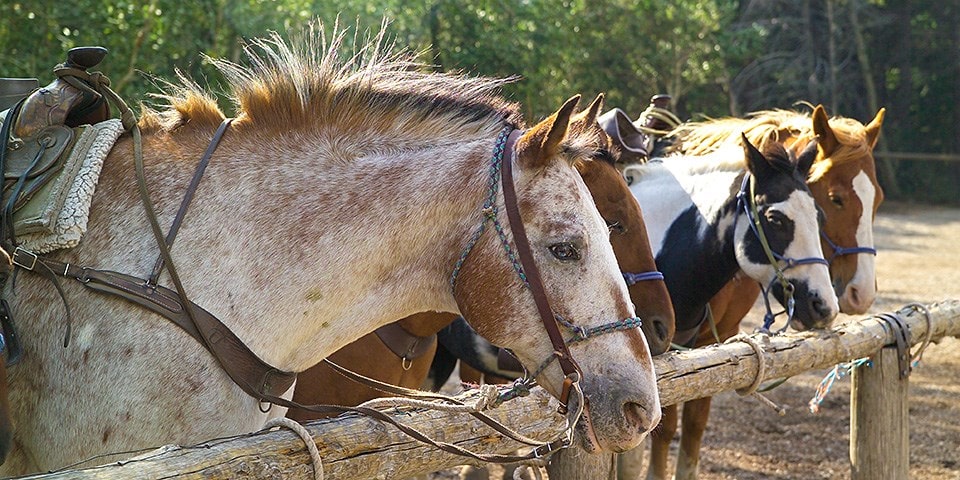
Photo Credit: National Park Service & David Restivo (Labeled for Reuse)
If you’re tying the horse to a stand-alone hitching post (e.g. along the side of a barn), your horse will likely have good visibility. This is calming to prey animals, and your horse is more likely to stand quietly.
Tying a horse to the back wall of a stall, or in a dark corner of a barn, where they can’t see what’s happening around them can make them nervous.
Occasionally, you’ll see hitching rings attached to buildings instead of hitching posts. (This is more common in Europe.)
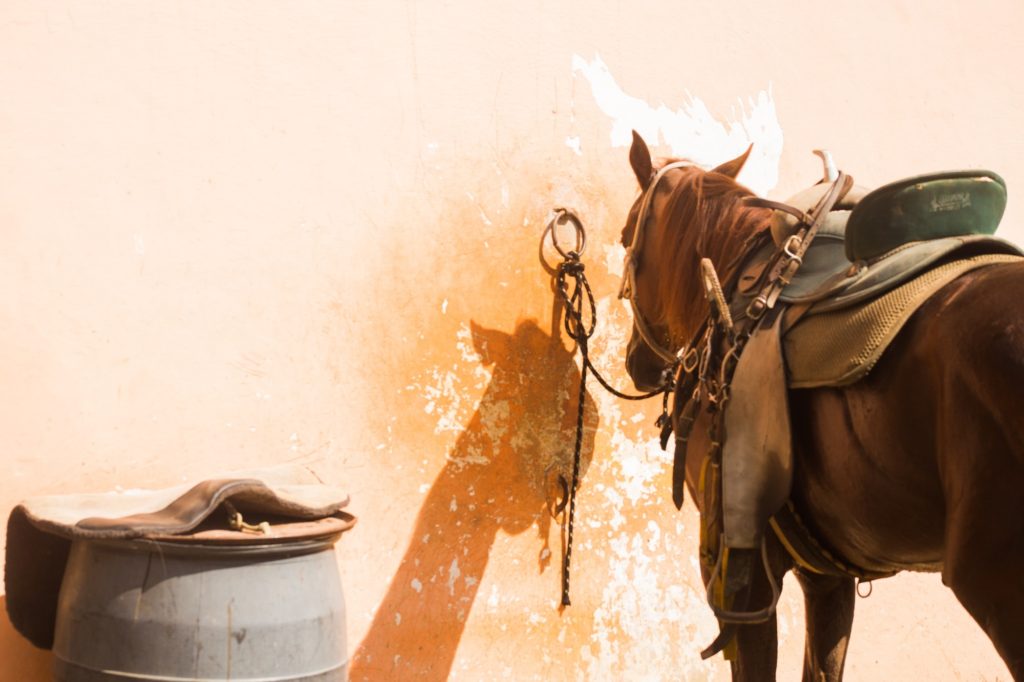
Some barns also have hitching rings available
How to Tie a Quick Release Knot
The safest way to tie a horse is with a quick release knot. If your horse spooks, these knots allow you to quickly pull the end of the rope and release them.
Some horses spook initially, then panic more when they realize they are restrained.
If you can quickly release the horse in an emergency, you’re more likely to be able to calm it down without injuries or property damage.
So how do you tie a quick release knot? There are many acceptable ways, but we’ve chosen a few of our favorites.
Here’s a Riding Warehouse step-by-step tying video:
Here’s another video tutorial from the American Quarter Horse Association:
Learn how to tie even more equestrian knots in Reference Ready: Essential Horse Knots, my favorite pocket guide.
How to Put a Horse in Cross Ties
Hitching rails aren’t the only way to keep your horse in one place. Many barns feature something called cross ties, which are essentially two ropes that can be clipped to both sides of a horse’s halter in an aisle.
Clip the snap end (below left) to the halter and the quick release mechanism (below right) to the wall.
This way, if the horse spooks, you can quickly release the end that’s tied to the wall without nearing your horse’s head or hooves.
If the horse runs away, you then have the rest of the cross tie to grab, which may make the horse easier to catch.
Just make sure your cross ties aren’t adjusted too short — your horse should still be able to move its head and move back and forth a few steps.
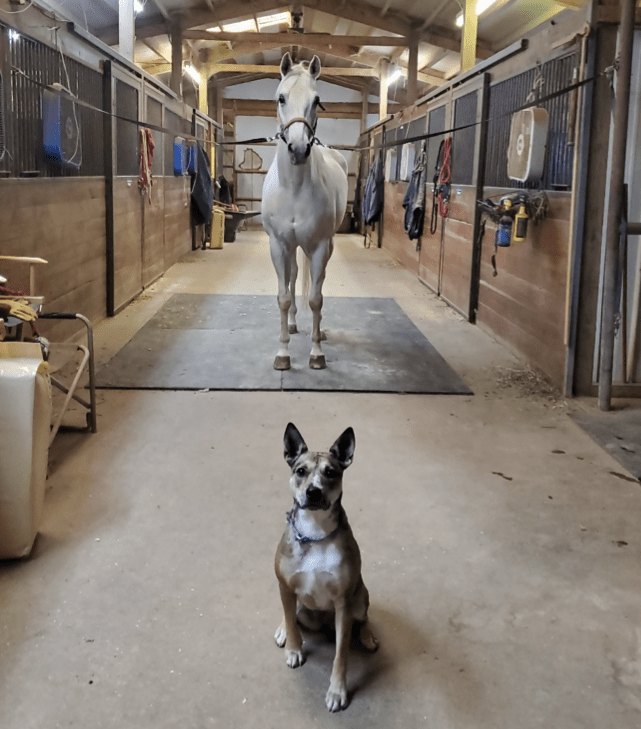
Cross ties are commonplace in many barns — including mine!
How NOT to Tie a Horse
Now that you understand the basics of using a hitching rail and cross ties, let’s touch on a few rookie mistakes to avoid:
- Don’t tie a horse lower than the height of its withers. They could get their legs caught in the rope.
- Don’t tie a horse so close to the hitching post or ring that it can’t hold its head normally.
- Don’t tie a horse so far from the hitching post that it can get its head under the rail or legs over the rope.
- Don’t tie a horse to a fence board (i.e. horizontal planks) unless you use a piece of twine between your rope and the fence. It’ll break easily if the horse pulls back. (Note: You may tie to a fence post — the vertical pieces that go into the ground.)
- Don’t tie a horse to anything that moves, such as a gate, bush, small tree, or a trailer that’s not connected to a tow vehicle.
- Don’t tie from a hitching rail, ring, or cross tie to the horse’s bit or bridle — only connect to a halter.
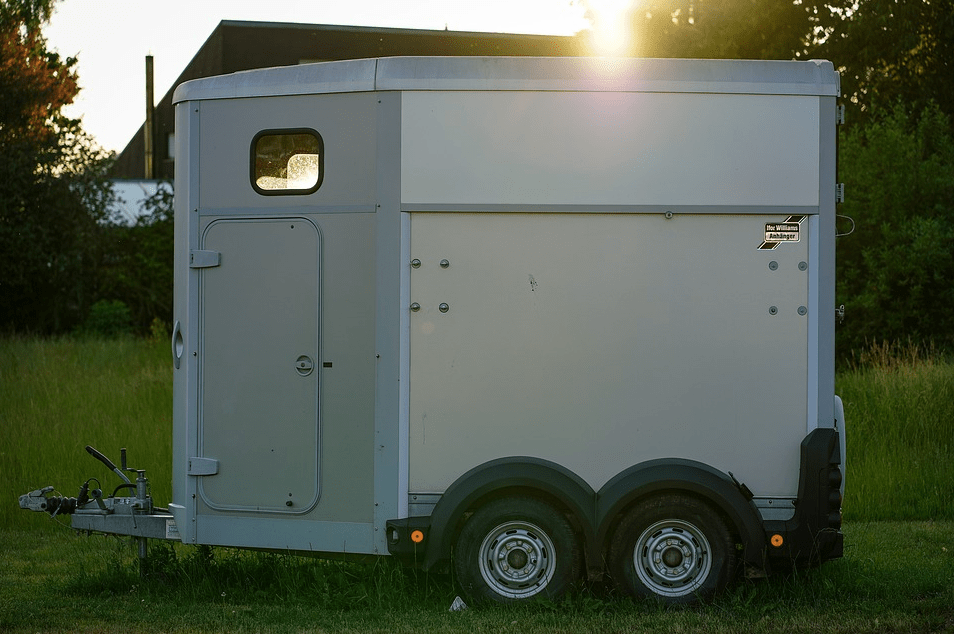
Never tie a horse to a trailer that doesn’t have a tow vehicle attached
Everything Has Risks
Some horses are spookier than others, including my Appendix Quarter Horse. (I’m pretty sure the Thoroughbred half of his brain is responsible when he spooks, not the Quarter Horse half!) He’s spooked at:
- Loud children who scream and run around.
- Flying debris, such as plastic bags in the wind.
- Anything out of the ordinary, like the time I accidentally dropped a folded piece of paper while riding.
- Other horses on trails or in barn aisles.
- Horses in Halloween costumes… OK, I guess I can’t blame him for that!
The vast majority of the time, though, if tied properly, horses stay perfectly safe. But accidents do happen, which is why every equestrian needs to know how to tie a quick release knot.
Remember to practice tying quick release knots a LOT!
When in doubt, play it safe—it’s easier to spend a few additional minutes finding a better spot to tie a horse than dealing with broken equipment, a loose horse, or an injury that could have been prevented.
Frequently Asked Questions
How high should a horse hitching post be?
The generally accepted height recommendation is 42 inches, or three and a half feet tall. You can have a taller post if you’d like, but keep the rings at 42 inches.
This height is convenient for you and comfortable for your horse. They can easily lower their head to the ground and possibly nibble on the grass (if there is any), or just enjoy a good stretch.
Make sure you always secure your horse to a hitching post with a quick-release knot and leave a little rope length so they can move their heads around.
How deep should a hitching post hole be?
You want a hitching post hole to be at least four feet deep. The pole needs to be firmly in the ground in case the horse pulls backward (you don’t want your horse to spook, pull the pole free, and be dragging it along, banging into his legs, as he runs away).
Make sure the pole is vertical, and secure it further with concrete (instead of just trying to pack the dirt back in). Once the concrete is dry, your hitching post pole should be stable.
P.S. Enjoy this article? Trot on over to:
- How to Safely Tie Horses in a Trailer (Tips, Video, etc.)
- Corral Cards Review: Horse Knot Tying Pocket Guide
- Horseback Riding Safety Equipment That’s Worth Every Penny
- How Often to Replace a Horseback Riding Helmet
- 7 Best Safety Stirrups for Adults
- How Safety Stirrups Work
- Why Western Riders Don’t Wear Helmets


